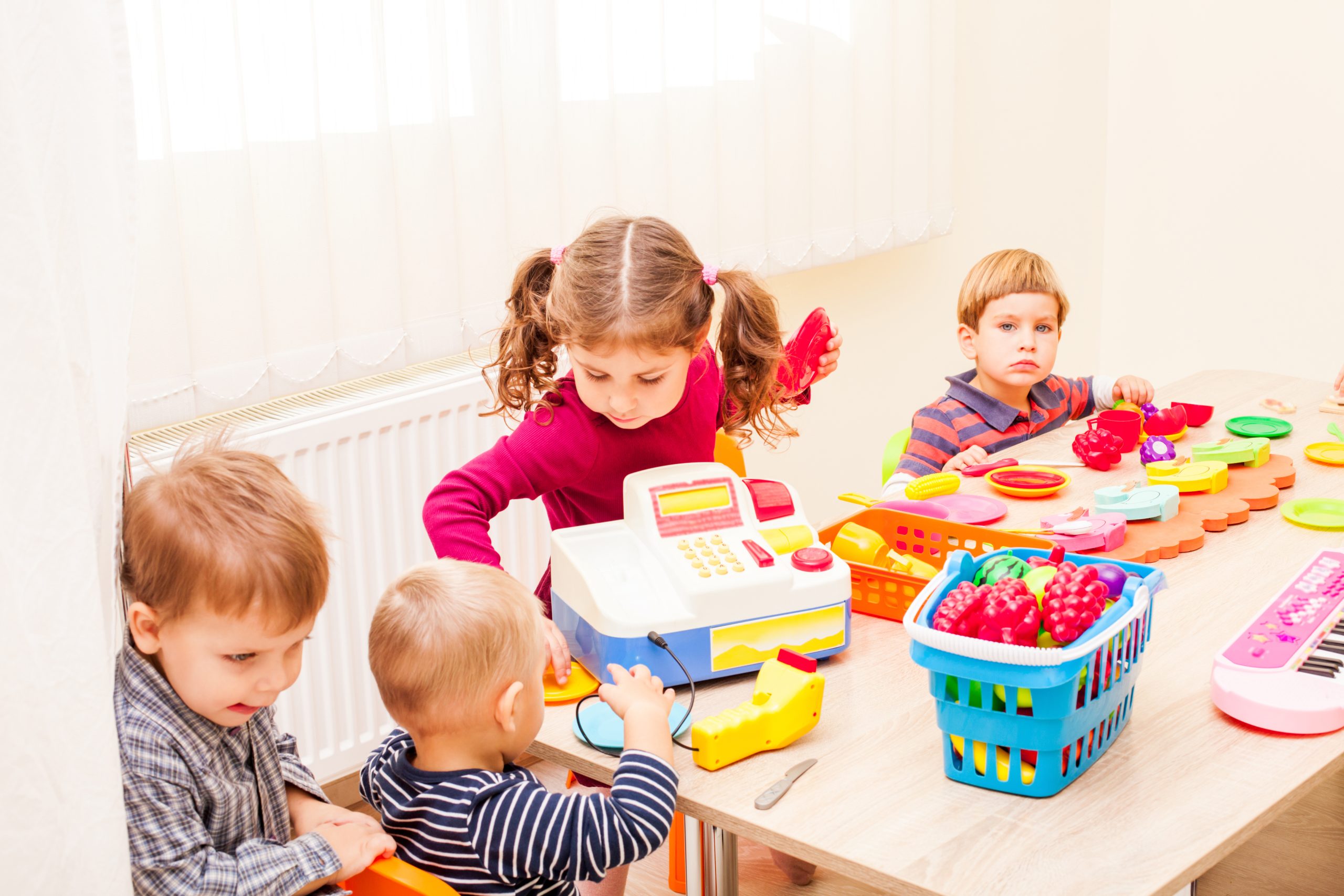Kids love to play—and it’s also an important aspect of their development! Symbolic play, also called “pretend play”, is an enriching activity for little ones that helps to advance their cognitive and language landscapes. But what exactly is symbolic play, and how does it work its magic? To put it broadly, this type of play involves children using objects, actions, or ideas to represent other objects, actions, or ideas. It uses their imagination and creativity. A simple wooden block transforms into a roaring car, while a piece of cloth becomes a superhero cape. While this can appear as simple entertainment, it is also part of a pivotal framework nurturing foundational cognitive and linguistic growth. Jean Piaget, the eminent developmental psychologist, identified play as a key catalyst in his Four Stages of Cognitive Development theory. Symbolic play begins to take on an important role during the pre-operational stage, and is commonly observed in children aged two to seven years of age. This stage, characterised by the development of language and imagination, has symbolic play as a crucial element and theme. Symbolic play contributes to the expansion of vocabulary as children identify objects and assign them names. However, it extends beyond that: they can also improve their conversation skills and begin to explore negotiation and narrative construction as they create stories and characters during their play. For educators and parents, encouraging symbolic play is not merely about keeping children engaged; it's about paving the way for cognitive and linguistic development.

What is Symbolic Play?
It’s clear from research done by Piaget and others that symbolic play has a very influential role in early development. What does it look like, and how can you know when children are taking part in it? It’s fairly simple: symbolic or pretend play entails children using objects, gestures, or ideas to represent other objects, actions, or ideas. It's essentially the art of using symbols. For instance, a child may use a banana as a telephone, engaging in imaginative conversations with imaginary friends or 'calling' family members. This play is foundational to the development of abstract thinking. Several features distinguish symbolic play:
- Use of representation
Children use one thing to symbolise another.
- Imagination and creativity
Play moves beyond concrete reality, exploring an array of scenarios and roles.
- Development of rules
Children create and adhere to specific rules, even in imagined scenarios.
- Language expansion
Play is narrated and verbalised as children create stories and conversations.
What Distinguishes Symbolic Play from Other Forms of Play?
The world of play is a vast and varied one—but symbolic play has a unique niche. While it can be mixed with other forms of play, the aspects outlined in the previous section distinguish it and set it apart. It can be contrasted with functional play, where children use objects as intended. Symbolic play involves transforming objects beyond their original purpose. Rolling a toy car on the floor is functional, but using it as a flying superhero vehicle enters the realm of symbolic play. Similarly, constructive play involves building, while symbolic play might involve imagining a tower as a castle under siege. Symbolic play is about "pretending", while other forms of play focus on "doing" or "creating". It’s a subtle difference but a profound one, as this specific type of play has a crucial role in cognitive and linguistic development. It bridges concrete operations and abstract thinking.

The Cognitive Advantages of Symbolic Play
Symbolic play both demonstrates cognitive development and lays a foundation for further advancements. Here’s how it can help children to extend and enrich their learning:
Enhancing Imaginative Capacities
Symbolic play is a key to a child’s imagination, allowing them to create worlds, characters, and more. A cardboard box can become a spaceship and take children to traverse galaxies, encountering aliens and maybe even saving other astronauts from danger. This imaginative exercise stretches boundaries in their brains, widening their lens of possibility.
Problem-Solving and Critical Thinking Development
As they navigate their imaginary worlds, children face challenges and find solutions. Whether their spaceship 'breaks down' or the pretend tea is 'too hot', solving these problems sharpens critical thinking skills. Children learn to approach problems from various angles, honing their problem-solving abilities.
Fostering Creativity and Abstract Thinking
Symbolic play is an exercise in abstraction. A stick becomes a magic wand, a towel transforms into a superhero cape. This leap from concrete to abstract fosters fluid thought, preparing minds to grasp complex concepts more readily in later educational stages.

Language Development Through Symbolic Play
It’s no secret that childhood is when a huge amount of our language develops. There is an intricate interplay between play and language growth, and symbolic play in particular emerges as influential in this process. It helps to build robust linguistic foundations through imaginative scenarios and make-believe interactions.
Role in Vocabulary Expansion
Each imaginative scenario introduces children to new words and concepts. Whether it’s diagnosing teddy bear patients or concocting amazing imaginary dishes, role-play scenarios expose children to new vocabulary and expand their linguistic toolbox.
Facilitating Conversational Skills
Symbolic play often involves dialogue and provides invaluable practice in taking turns, asking questions, and expressing thoughts. It's a safe space where children can learn about being a good conversationalist, honing their skills without real-world pressures.
Enhancing Narrative/Storytelling Abilities
Creating tales and stories as part of their play exercises a child’s narrative skills. They can learn story structure, characters, and even early writing skills as they 'document' their imaginary adventures.

Broader Educational Implications
Symbolic play is influential in many different aspects of life and learning. Educators can use it as a tool within various subjects to support specific curricular goals. Here are a few examples:
- Mathematics
Through make-believe shopping trips or playing 'house', children are introduced to concepts of counting, measuring, and basic arithmetic.
- Literacy
The narratives laid out during play nurture a child's understanding of story structure, characters, and even early writing skills if they write down the stories they’re creating.
- Science and understanding the world
When a child pretends their toy is sick and needs medicine, they're exploring rudimentary concepts of biology and cause-effect relationships.
Preparing Children for Structured Learning Environments
One very significant implication of symbolic play in the education setting is that it can bridge the unstructured world of early childhood and the more organised world of formal schooling. As mentioned earlier, children practice patience, turn-taking, collaboration, and conflict resolution within these imaginative scenarios. These critical soft skills are often overshadowed by academic milestones. However, they are foundational in preparing children as they progress into more structured learning environments.

Recommendations for Educators and Parents
We’ve made the case for symbolic play as an important part of learning. The following are some tips for using it to best effect at school and at home:
- Create a resource-rich environment.
Whether it’s a classroom corner or a living room nook, a space filled with props like utensils, dolls, costumes, or cardboard boxes can facilitate imaginative scenarios. Sometimes the simplest objects can evoke the richest narratives.
- Role model.
Children will copy the adults around them. Engage in symbolic play yourself, showing how a banana might become a telephone or a shoe transforms into a car. This not only spurs their imagination but also strengthens the child-adult bond.
- Incorporate narratives.
Encourage children to verbalise their play. Prompt them with open-ended questions: “Tell me about your spaceship journey” or “What’s happening in your jungle adventure today?”
Addressing Potential Concerns and Overcoming Challenges
Concern: Lack of structured learning. Some educators or parents might fear that symbolic play detracts from formal education. The solution to this is balance! Integrating structured learning goals into play scenarios can create a blend of formal instruction and imaginative exploration. Concern: Over-reliance on toys. The modern market is inundated with 'educational' toys, often prohibiting or minimising imaginative play. The solution is to diversify play resources. Mix these commercial toys and learning aids with everyday objects, allowing a child’s creativity to fill in the blanks.
Resources and Tools to Support Symbolic Play-Driven Learning
Want to learn more and equip yourself to support learners with symbolic play? There are resources available!
- Workshops and Training
Organisations like the British Association for Early Childhood Education periodically conduct workshops focused on play-based learning.
- Reading Materials
Books like "Playing and Learning Outdoors" by Jan White provide insights into outdoor symbolic play opportunities. We’ve listed more relevant reading at the end of the article.
- Online Platforms
Websites such as Teach Early Years offer many articles and resources centred on the importance of play in early education.

In Summary
There’s power in play! It’s clear that symbolic play is a major force in a child’s cognitive and language development, creating opportunities to learn and expand thinking. Of course, play is also joyful and entertaining for kids—a positive activity in many different ways. They are having fun while becoming the next great communicators, philosophers, and engineers. Educators and parents alike can harness the transformative power of symbolic play as they nurture young minds. Learn more about symbolic play and other important educational tools with our range of CPD courses for teachers.
Recommended Reading & Resources:
- The Power of Play: Learning What Comes Naturally by David Elkind - - A holistic view on the role of play in child development.
- Symbolic Play: The Development of Social Understanding by Dorothy G. Singer & Tracey Revenson - Examining the psychological aspects of play.
- Play and its Role in the Mental Development of the Child by Vygotsky - A classic exploration by a renowned theorist.
- The Hundred Languages of Children: The Reggio Emilia Experience in Transformation by Carolyn Edwards - Insights into an innovative educational approach.
- Children's Play and its Place in Education by Walter Wood - Contextualising play within formal education.

